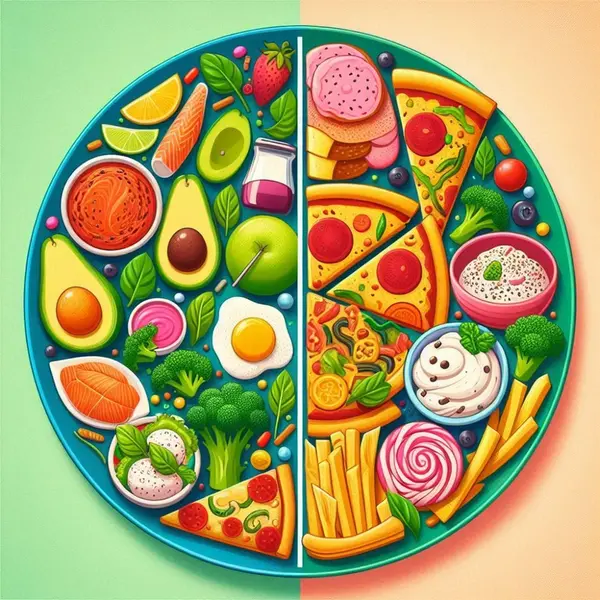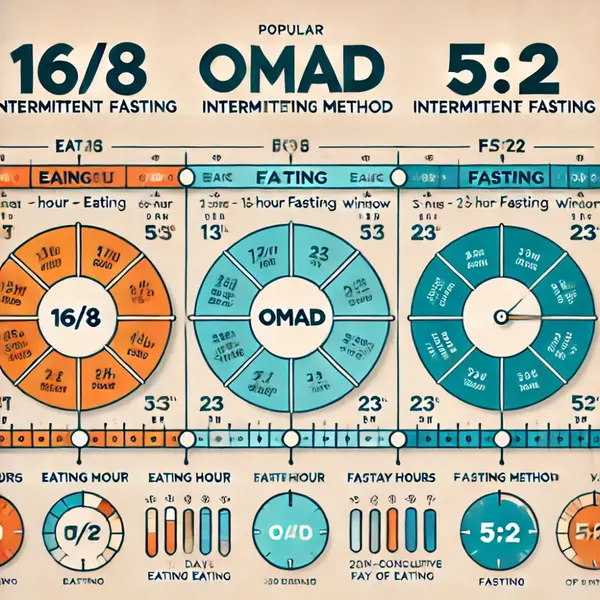Part 5: Feast, Fast, and Conquer: The Guide to Eating Like a Warrior
Welcome to Part 5 of our transformative weight loss journey! So far, we’ve explored the science of metabolism, the power of setting SMART goals, and the fundamentals of nutrition. Now, it’s time to put theory into practice.
In this chapter, we’ll dive deep into how to seamlessly integrate powerful dietary strategies into your everyday life. It’s not just about following a plan—it’s about owning your nutrition, eating with purpose, and developing a relationship with food that gives you control, confidence, and freedom. Whether you’re embracing the balance of a calorie-restricted diet or harnessing the power of a ketogenic, time-restricted approach, the key to success lies in practical execution.
Get ready to unlock the warrior within, with actionable steps, proven meal strategies (Part 6), and expert tips to conquer your hunger, balance your body, and thrive for life. We’ll cover everything from the right foods to fuel your body to optimizing your fasting window. By the end of this guide, you’ll be equipped with the tools you need to turn these strategies into lifelong habits that will lead to lasting change.
It’s time to take control of your nutrition and create the life you’ve always wanted—starting with what’s on your plate.
Macronutrient Ratios for a Ketogenic Diet
Do you remember the macronutrient ratios in a ketogenic diet? Here they are again:
- Fat: 70–75%
- Protein: 20–25%
- Carbs: 5–10% of total daily calories.
The list of foods you should eat and avoid is extensive, but it’s essential to have a comprehensive overview:
1. Healthy Fats
As discussed, healthy fats are the cornerstone of the keto diet, providing your body with energy while keeping you satiated.
- Oils and Fats: Extra virgin olive oil Coconut oil Avocado oil Ghee (clarified butter) Grass-fed butter MCT oil (medium-chain triglycerides)
- Nuts and Seeds: Almonds, macadamia nuts, walnuts, pecans Chia seeds, flaxseeds, pumpkin seeds, sunflower seeds Nut butters (without added sugars)
- Avocados: High in healthy fats and fiber.
- Olives: Both green and black varieties, rich in monounsaturated fats.
2. Protein Sources
Adequate protein intake is crucial for maintaining muscle mass while in ketosis. Focus on moderate portions.
- Meats (preferably organic and grass-fed): Beef (steak, ground beef, roast) Lamb, pork (bacon, chops) Poultry (chicken, turkey, duck)
- Fish and Seafood (preferably wild-caught): Salmon, mackerel, sardines (high in omega-3) Tuna, trout, shrimp, crab, lobster Oysters, mussels, clams (shellfish in moderation)
- Eggs: Free-range or organic, rich in nutrients and highly versatile.
3. Low-Carb Vegetables
Non-starchy vegetables are your go-to for vitamins, minerals, and fiber without spiking blood sugar.
- Leafy Greens: Spinach, kale, Swiss chard, arugula, lettuce Collard greens, mustard greens
- Cruciferous Vegetables: Broccoli, cauliflower, Brussels sprouts, cabbage Bok choy, kohlrabi
- Other Low-Carb Vegetables: Zucchini, cucumber, bell peppers, asparagus Green beans, celery, radishes, mushrooms, leeks Eggplant, tomatoes (in moderation), onions (in moderation)
- Fermented Vegetables: Sauerkraut, kimchi (great for gut health)
4. Dairy (Full-Fat and Low-Carb)
Dairy can be included in moderation, but opt for full-fat versions without added sugars.
- Cheese: Cheddar, Gouda, Brie, mozzarella, goat cheese, blue cheese, Parmesan
- Full-fat Greek yogurt (unsweetened)
- Heavy cream (not half-and-half)
- Sour cream
- Cottage cheese (check for low-carb content)
5. Beverages
Hydration is crucial on Keto, especially when your body is flushing out water. Stick to non-sugar drinks.
- Water (drink plenty, consider adding electrolytes)
- Sparkling water (unsweetened)
- Tea (black, green, herbal)
- Coffee (black, or with MCT oil, coconut oil, or heavy cream)
- Bone broth (homemade or low-sodium varieties)
6. Keto-Friendly Sweeteners
To satisfy your sweet tooth, use natural, low-carb sweeteners that won’t spike insulin.
- Stevia
- Erythritol
Avoid artificial sweeteners like aspartame or sucralose, as they can interfere with ketosis and lead to cravings.
7. Berries (In Moderation)
Berries are the best fruit option on Keto because they are lower in sugar and high in fiber.
- Raspberries
- Blackberries
- Strawberries
- Blueberries (in small amounts)
8. Condiments and Spices
Spices and condiments add flavor without carbs, but check labels for hidden sugars.
- Salt, pepper, garlic, turmeric, cumin, paprika, oregano
- Vinegars: Apple cider vinegar, balsamic vinegar (small amounts)
- Mustard, hot sauce, salsa (sugar-free)
- Mayonnaise (made with healthy oils)
9. Snacks
When hunger strikes, having Keto-friendly snacks on hand is helpful.
- Pork rinds
- Cheese crisps
- Seaweed snacks
- Hard-boiled eggs
- Nut butters (without added sugar)
- Beef jerky (check carb content)
10. Keto-Friendly Extras
These can add variety to your meals without breaking ketosis.
- Dark chocolate (85% cocoa or higher, Keto version)
- Almond flour, coconut flour (for low-carb baking)
- Shirataki noodles (low-carb alternative to pasta)
There are several foods to avoid:
- Any processed foods
- Grains (wheat, rice, oats, corn)
- Sugary foods (cakes, cookies, soda, fruit juices)
- High-carb fruits (bananas, apples, oranges, grapes)
- Starchy vegetables (potatoes, sweet potatoes, peas, corn)
- Processed foods and refined oils (canola, vegetable oil)
- Legumes (beans, lentils, chickpeas)
- Alcohol (especially beer and sugary cocktails)

You might wonder: ""Should I really avoid red meat or monounsaturated fat? And why can’t I eat fruit?"" This seems to contradict what we’ve learned over the past decades about healthy eating. Remember the discussion in Part 4 where we explained why this is necessary. Feel free to review that article if you need a refresher.
Strategies for Incorporating Intermittent Fasting: Finding the Right Approach for You
As discussed before, combining Keto with intermittent fasting (IF) is a powerful tool for enhancing your Keto journey and taking your fat-burning potential to the next level. The idea is simple: alternate between periods of eating and fasting to allow your body to tap into stored fat for energy, improve insulin sensitivity, and support overall metabolic health. The key, however, is finding the right fasting protocol that fits your lifestyle and goals.
Here are several intermittent fasting strategies, each with its own unique benefits:
1. 16/8 Method: The Beginner’s Gateway
One of the most popular and accessible fasting protocols, the 16/8 method involves fasting for 16 hours each day and eating during an 8-hour window.
- How it works: If you finish dinner at 8 p.m., you would fast until 12 p.m. the next day, then eat from 12 p.m. to 8 p.m. This typically includes skipping breakfast, making it convenient.
- Benefits: This method gives your body a break from constant digestion, allowing insulin levels to drop and promoting fat burning. It’s also easy to fit into most routines without feeling too restrictive.
2. OMAD (One Meal a Day): A Simple, Efficient Fast
For those who prefer simplicity, OMAD involves fasting for 23 hours and eating all your daily calories in one sitting.
- How it works: Eat one large Keto meal at the same time each day, typically within a 1-hour window. Drink plenty of water and low-calorie beverages during the rest of the day.
- Benefits: OMAD can simplify your life while keeping your body in a prolonged fasting state, which promotes fat loss, mental clarity, and steady energy levels.
3. The 5:2 Diet: Flexible and Sustainable
For those who want a more flexible approach, the 5:2 diet allows you to eat normally five days a week while restricting calories to around 500–600 for two non-consecutive days.
- How it works: Choose two days in the week to restrict calories, eating small meals that keep you within the 500–600 range. On the remaining five days, you eat normally, without specific calorie limits.
- Benefits: This method offers flexibility and allows you to enjoy regular meals most of the week. On fasting days, it encourages fat loss while supporting your metabolism.
4. Warrior Diet: Eat Like a Hunter-Gatherer
The Warrior Diet is inspired by the ancient eating patterns of warriors, where you fast during the day and feast at night.
- How it works: Fast for 20 hours each day, eating only small amounts of raw fruits, vegetables, and protein, then consume one large meal in the evening.
- Benefits: This diet mirrors the natural eating patterns of our hunter-gatherer ancestors and helps you stay in a fat-burning state throughout the day while enjoying a satisfying feast in the evening.

As we move deeper into our journey, Part 6 will focus on fine-tuning your ketogenic lifestyle for maximum health benefits. While keto has proven effective for weight loss and energy, it's important to address potential concerns, especially around blood markers and heart health. This chapter will guide you through balanced meal strategies designed to promote overall wellness while keeping you in ketosis.
We'll address questions like:
- Are there ways to optimize meal choices to support heart health on keto?
- How can you monitor and improve blood markers while following a high-fat diet?
- What adjustments can you make if you experience concerns, such as elevated cholesterol?
From adjusting fat sources to incorporating targeted supplements and nutrient-rich foods, Part 6 will give you actionable steps to ensure your keto lifestyle supports not only weight loss but also lasting health. To get you started, we’ll provide a simple meal plan for your first day, making it easy to dive in with confidence.